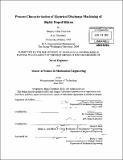Process characterization of Electrical Discharge Machining of highly doped silicon
Author(s)
Crawford, Gregory Allan
DownloadFull printable version (25.34Mb)
Alternative title
Process characterization of EDM of highly doped silicon
Other Contributors
Massachusetts Institute of Technology. Dept. of Mechanical Engineering.
Advisor
David E. Hardt.
Terms of use
Metadata
Show full item recordAbstract
Electrical Discharge Machining (EDM) is an advanced machining process that removes material via thermal erosion through a plasma arc. The machining process is accomplished through the application of high frequency current (typically through a fine wire or some other electrode) to a conductive workpiece. The electrode is physically separated from the workpiece by some small distance and the potential difference is commonly discharged through an insulating dielectric material such as deionized water or oil. This short duration application of current produces a spark across the gap between the electrode and workpiece, causing vaporization and melting of local material in both the electrode and workpiece. The EDM process is most frequently used for conductive substrates (i.e. metals); however, research has shown that the process may be successfully used on semiconductor substrates such as doped silicon wafers'. The purpose of this research was to characterize the EDM process using Design of Experiments (DOE) statistical methodology on highly doped silicon wafer workpieces for material removal rate (MRR) and surface roughness (Ra) for both Wire EDM (WEDM) and die sinker EDM machines. Once process characterization was completed, confirmation testing was conducted for each machine. The applied spark energy had a significant impact on processing speed for both machines as expected, with the WEDM processing also heavily dependent on selected control speed. Surface roughness was also found to be highly dependent on spark energy for both machines. Evaluation of minimum obtainable feature sizes for some specific geometries as well as evaluation of various effects on the processing of silicon were also conducted.
Description
Thesis (Nav. E. and S.M.)--Massachusetts Institute of Technology, Dept. of Mechanical Engineering, 2012. Cataloged from PDF version of thesis. Includes bibliographical references (p. 107).
Date issued
2012Department
Massachusetts Institute of Technology. Department of Mechanical EngineeringPublisher
Massachusetts Institute of Technology
Keywords
Mechanical Engineering.